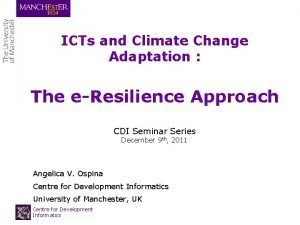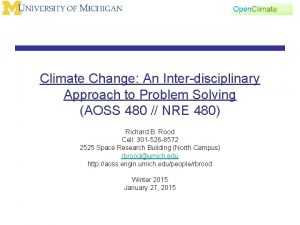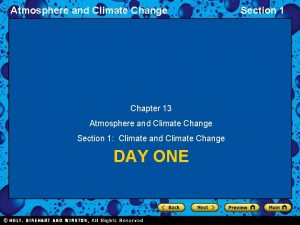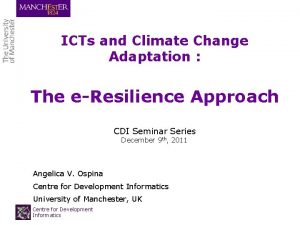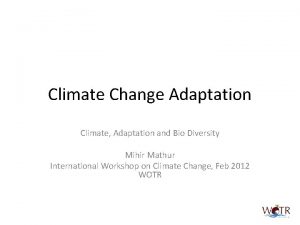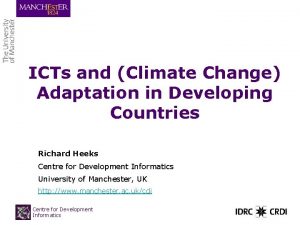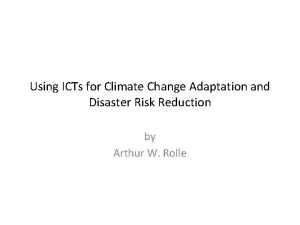ICTs and Climate Change Adaptation The eResilience Approach









- Slides: 9

ICTs and Climate Change Adaptation : The e-Resilience Approach CDI Seminar Series December 9 th, 2011 Angelica V. Ospina Centre for Development Informatics University of Manchester, UK Centre for Development Informatics

Outline Background 1) Adaptation to Climate Change Framework 2) Systemic Resilience to Climate Change: e-Resilience, Examples and Challenges 3) Implications for ICTs & Resilience Thinking Conclusions Centre for Development Informatics

Background • ‘Climate Change, ICTs and Innovation’ project (2009 -2012). • CDI in partnership with Canada’s IDRC. • “Linking ICTs and Climate Change Adaptation: A Conceptual Framework for e-Resilience and e-Adaptation” http: //www. niccd. org/Conceptual. Paper. pdf • Ph. D Research (ongoing) Centre for Development Informatics

1. Adaptation to Climate Change: “SLA Plus” Approach Vulnerability Dimensions Vulnerability Context System Levels: MACRO Acute Shocks Chronic Trends MESO Livelihood System Livelihood Determinants Functionings • Assets • Institutions MICRO Livelihood Capabilities • Structures Development Outcomes ADAPTATION/ ADAPTIVE ACTIONS Climate Change Centre for Development Informatics Ospina & Heeks (2011)

2. Systemic Resilience to Climate Change Resilience as Sub-properties of livelihood systems: ü Robustness ü Rapidity ü Scale ü Redundancy ü Flexibility & Diversity ü Self-organisation ü Learning ü Equality Centre for Development Informatics

2. Systemic Resilience to Climate Change: e-Resilience Vulnerability Dimensions Vulnerability Context MACRO Acute Shocks Chronic Trends Livelihood System Levels: MESO Livelihood Determinants Livelihood Capabilities • Assets • Institutions MICRO Development Outcomes Functionings ADAPTATION/ ADAPTIVE ACTIONS • Structures Climate Change Resilience Sub-properties ICTs Robustness Centre for Development Informatics Rapidity Scale Redundanc Flexibility & Diversity Selforganisation Learning Equality Ospina & Heeks (2011)

3. Implications for ICTs & Resilience Thinking • Understanding livelihoods resilience : Role of tools such as ICTs in support of information, knowledge and innovation. • e-Resilience Sub-properties: Strengthen vulnerable systems response to cc challenges. • A model that goes beyond climate change. • Consideration of the underlying factors of vulnerability, including issues of power and inequality. • New and traditional knowledge. Centre for Development Informatics

Conclusions • From withstanding and recovering from short-term events, to adjusting, changing and transforming their livelihoods in the long term with the help of ICTs. • From reductive to systemic frameworks. • From components and processes to studying properties (e-resilience). • Challenge of measuring resilience and ICTs’ contribution Centre for Development Informatics

Useful Links • NICDD Project Website: www. niccd. org • Online Network on ICTs, Climate Change and Development: http: //groups. google. co. uk/group/niccd • Blog: http: //niccd. wordpress. com/ Centre for Development Informatics
 Climate change 2014 mitigation of climate change
Climate change 2014 mitigation of climate change Eresilience
Eresilience Icts dublin airport
Icts dublin airport Ku leuven laptop
Ku leuven laptop Interdisciplinary approach to climate change
Interdisciplinary approach to climate change Interdisciplinary approach to climate change
Interdisciplinary approach to climate change Climate change meaning
Climate change meaning Chapter 13 atmosphere and climate change section 1
Chapter 13 atmosphere and climate change section 1 Chapter 13 atmosphere and climate change
Chapter 13 atmosphere and climate change Climate change paragraph
Climate change paragraph

